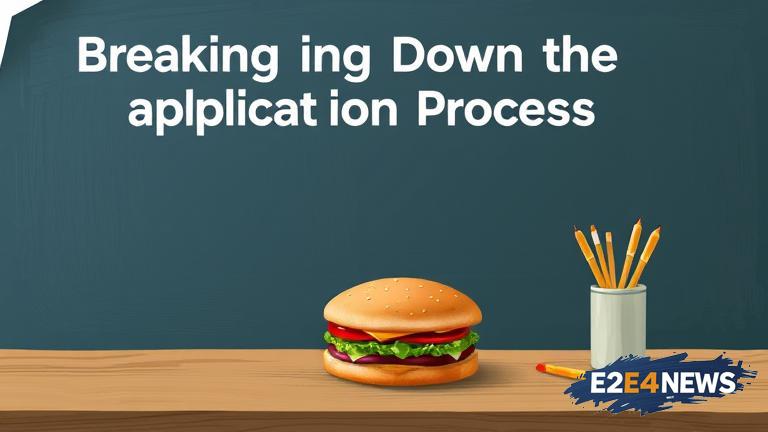The application process for free and reduced lunch programs in schools can be complex and overwhelming for many parents. However, understanding the eligibility criteria and the steps involved in applying can make a significant difference in ensuring that children from low-income families receive the nutrition they need to succeed in school. The free and reduced lunch program is a federally funded initiative that provides meals to students who meet certain income guidelines. To be eligible, families must have a gross income that is at or below 130% of the federal poverty level for free meals, or between 130% and 185% of the federal poverty level for reduced-price meals. The application process typically begins at the start of each school year, and parents can apply online or by submitting a paper application. The application will require families to provide detailed information about their income, household size, and other relevant factors. Once the application is submitted, it will be reviewed by the school district to determine eligibility. If approved, students will receive free or reduced-price meals for the entire school year. It is essential for parents to apply for these programs, as they can make a significant difference in the health and well-being of their children. Proper nutrition is critical for cognitive development, and students who receive free or reduced-price meals tend to perform better academically. Additionally, these programs can help reduce the financial burden on families, allowing them to allocate their resources more effectively. The application process is typically straightforward, but some families may encounter difficulties or have questions about the process. In such cases, it is recommended that they contact the school district or a local non-profit organization that specializes in assisting with the application process. These organizations can provide guidance and support to ensure that families receive the benefits they are eligible for. Furthermore, some schools may offer additional resources and services to support students who receive free or reduced-price meals, such as food pantries or summer meal programs. It is crucial for parents to be aware of these resources and to take advantage of them to ensure that their children receive the support they need. In conclusion, the application process for free and reduced lunch programs is an essential step in ensuring that children from low-income families receive the nutrition they need to succeed in school. By understanding the eligibility criteria and the application process, parents can take the first step in providing their children with the resources they need to thrive. The benefits of these programs extend beyond the classroom, and can have a lasting impact on the health and well-being of children. As such, it is essential that parents take advantage of these programs and apply for free or reduced-price meals if they are eligible. By doing so, they can help ensure that their children receive the nutrition they need to succeed, and set them up for a lifetime of health and wellness. The application process may vary depending on the school district, so it is essential for parents to check with their local school district for specific information. Some school districts may offer online applications, while others may require paper applications. Additionally, some school districts may have specific deadlines for submitting applications, so it is crucial for parents to be aware of these deadlines to ensure that their children receive the benefits they are eligible for. Overall, the free and reduced lunch program is a vital resource for families, and the application process is a critical step in accessing these benefits. By providing detailed information about the application process and the eligibility criteria, parents can make informed decisions about their children’s nutrition and well-being. The program is designed to support low-income families, and the application process is intended to be straightforward and accessible. However, some families may still encounter difficulties or have questions about the process, and it is essential that they seek guidance and support from the school district or local non-profit organizations. By working together, parents, schools, and communities can ensure that all children have access to the nutrition they need to succeed, regardless of their family’s income level. The free and reduced lunch program is a critical component of the nation’s efforts to reduce child hunger and improve educational outcomes. By providing free or reduced-price meals to eligible students, the program helps to ensure that all children have the opportunity to succeed in school and beyond. The program is funded by the federal government, and is administered by the US Department of Agriculture. The program is available in all 50 states, and is an essential resource for families who are struggling to make ends meet. In addition to providing free or reduced-price meals, the program also helps to support local economies by purchasing food from local farmers and suppliers. The program is a win-win for families, schools, and communities, and is an essential component of the nation’s efforts to reduce child hunger and improve educational outcomes. The application process for the free and reduced lunch program is typically available in multiple languages, and is designed to be accessible to all families, regardless of their income level or language proficiency. The program is also designed to be flexible, and can accommodate families who have changing income levels or household sizes. By providing a safety net for families who are struggling to make ends meet, the program helps to ensure that all children have access to the nutrition they need to succeed, regardless of their family’s income level. The program is a vital resource for families, and the application process is a critical step in accessing these benefits. By working together, parents, schools, and communities can ensure that all children have access to the nutrition they need to succeed, and can help to reduce child hunger and improve educational outcomes.
